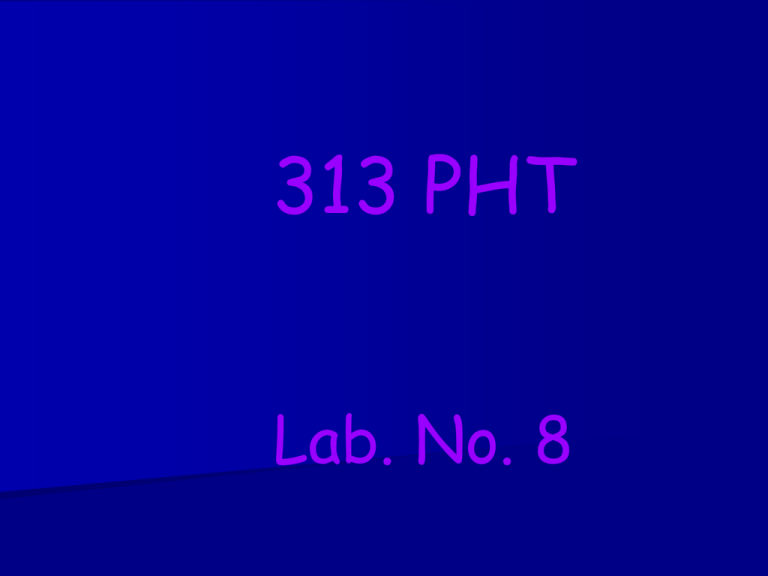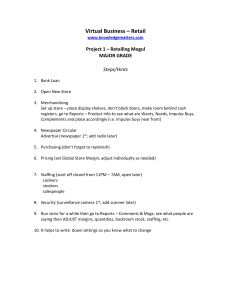lab 7 PHT313
advertisement

313 PHT Lab. No. 8 Gram’s Stain Gram’s +ve Cocci Gram’s -ve Bacilli Cocci Bacilli Pseudomonas Aerobic, non-fermentative, motile, oxidase-positive gramnegative bacilli. Most Important Species P.aeruginosa opportunistic pathogen causes UTI, wound infections and otitis media Microscopical examination: (morphology) A) Gram’s Stain: Gram –ve Non-sporeforming bacilli , having single arrangement. B) Examination of Motility: Using the “Hanging Drop technique” Pseudomonas is highly motile by means of polar flagella. Cultural characteristic: It grows on simple media. It usually produces exopigments. 1) Growth on nutrient agar: Its growth on nutrient agar showing greenish discolouration due to exopigment production. 2) Growth on Cetrimide Agar: Principle: Cetrimide agar is a highly selective medium for pseudomonas species due to presences of cetrimide which inhibits the growth of other bacteria. It contains also MgCl2 & K2So4 to facilitate production of the charactaristic green pigment of pseudomonas. Results: Only Pseudomonas species can grow on cetrimide agar showing growth of pale colonies with diffusion of green pigmentation. 3) Growth on MacConkey’s agar: Principle: MacConkey’s agar is a selective and differential medium selective medium for enteric gram –ve bacteria (bile salt inhibit the growth of non enteric bacteria). Test sugar: lactose. pH indicator: neutral red ( yellow in alkaline, pink in acidic pH). Biochemical reaction: 1)Oxidase test. 2) Nitrate Test. 3) Oxidation Fermentation (O/F) Test. 4) Growth on Triple Sugar Iron (TSI) agar. 1)Oxidase test: Results: +ve Test: Appearance of purple colour within few seconds. No colour purple colour +ve test Pseudomonas -ve test Enterobacteriaceae 2) Nitrate Test: Principle: Further reduction Nitrate reductase nitrite Nitrate Nirtogen (N2) α-naphthyl amine (nit. A) Sulphanilic acid (nit. B) Red diazonium salt Enterobacteriaceae If no red colour! Add zinc dust (reducing agent) Procedure: Nit.A test m.o Incubate at 35oC for 24 hrs Nitrate broth Red colour Nit. B No red colour Add zinc dust Results: Red colour after addition of nit.A & nit.B Reduction of Nitrate to nitrite Enterobacteriaceae Red colour after addition of zinc dust -ve reduction No red colour after addition of zinc dust Further reduction to Nitrogen Pseudomonas 3) Oxidation Fermentation (O/F) Test: Sensitive O/F test Results: Positive Test: O-/F- O+/F+ O+/F- Non Fermentative Oxidative Saccharolytic Enterobacteriaceae Pseudomonas O-/F+ 4) Growth on Triple Sugar Iron (TSI) agar: Principle: butt slant Results: 1. No Fermentation: Butt: alkaline (red) Slant: alkaline (red) Results: Butt: acidic (yellow) acidic (yellow) acidic (yellow) alkaline (red) Slant: acidic (yellow) alkaline (red) alkaline (red) alkaline (red) H2 S : -ve -ve +ve -ve Pseudomonas aeruginosa I'm also very resistant to most antibiotics, so it's very hard to get rid me. Bacteriological Examination of water, milk and air Examination of water, milk and air Water Milk Air Importance of water examination for pathogens Water intended for human consumption should not contain any pathogenic organisms. Water is used for many applications either at home for cooking ,washing or drinking in industries such as food and pharmaceuticals. or It is also important for hospitals for example haemodialysis unit Testing of water samples are done regularly to make sure of its safety Supplies of drinking water contaminated with sewage may cause diseases such as: typhoid fever and cholera. All sources of water should be tested regularly. Microorganisms which indicate the fecal pollution in water are usually common intestinal commensal bacteria. Most important indicators of fecal pollution of water Escherichia coli: The essential indicator of fecal pollution of human /animal origin. It is an important member of the coliform bacteria. Coliforms are members of the enterobacteriaceae family and they 1. grow in the presence of bile salts. 2. produce acid and gas from fermentation of lactose at 37°C. It is the commonly-used bacterial indicator of sanitary quality of food and water. • • • Enterococcus faecalis: less numerous than E.coli in human feces, but more resistant to chlorination. Clostridium perfringens: Less numerous in human feces Its spores can survive in the environment • Resist treatment processes than most of the indicators. Media used in bacteriological examination of water 1. For coliforms: MacConkey’s broth Containing bromocresol purple as the pH indicator. To confirm the presence of E.coli : EMB agar + IMVC Enterococcus faecalis: Glucose azide broth. Clostridium perfringes: Differential reinforced clostridial medium. Methods Used in Bacteriological Examination of Water Membrane Filtration Method Determination of Most Probable Number (MPN) by dilution method Pour plate technique Membrane Filtration Method • Using Millipore Filter Apparatus MacConkey’s agar Determination of MPN of Coliforms by Dilution Method 50 ml water sample 10 ml water sample 1 ml water sample Water Sample 50 ml DSMB 5 x 10 ml DSMB 5 x 5 ml SSMB Results: Positive tubes: showing production of acid or gas. Acid production: change color of tube from purple to yellow Gas production: detected in the Durham’s tube. Gas Purple Yellow Determine no. of coliforms per 100 ml water sample (MPN) using the standard probability table. 1 3 2 MPN = 14 i.e: No. of coliform bacilli per 100 ml water sample is 14 cells. Most probable number of coliforms by McCrady’s table Viable Bacterial Count Using 10 fold serial dilution method 1 ml water Water sample 1 ml 1 1 ml 2 1/10 x 1/10 1/10 Melted NA 1 ml 1 3 9 ml Saline 1/100 x 1/10 1/100 1/1000 1 ml 1 ml 2 3 Results: No. of colonies per plate Y Dilution factor 1 2 3 X X.y 10 x1 X1.y1 102 x2 X2.y2 x3 X3.y3 103 No. of cells per 1 ml = X1.y1 + X2.y2 + X3.y3 3 Examination of water, milk and air Water Milk Air Introduction: Human infections may be caused by theingestion of animal milk which contains microorganisms derived from: a. b. c. Animal e.g. by contamination with its feces The environment Milk handlers such as dairy workers Importance of milk examination for pathogens It is important to examine milk for pathogens to ensure that it is safe to be consumed by man. Milk is further used for obtaining many milk products like cheese ,cream , butter and ice cream Pathogenic bacteria present in milk E.coli Streptoccus pyogenes Mycobacterium bovis Bacillus anthracis Salmonella sp. Brucella sp. Determination of viable bacterial count: Using the pour plate method after preparation of 10 fold serial dilution from the milk sample with ringer solution. Permissible number of bacterial flora in pasteurized milk is 5 x 104 cfu/ml Permissible number of bacterial flora in long life milk is 10 cfu/ml Methylene Blue Reduction Test To determine quality of the milk Increasing the number of bacterial flora will reduce the color of methylene blue more rapidly due to increasing consumption of oxygen. i.e.: The speed of reduction of methylene blue color is directly proportional to the number of bacteria present in milk sample. Methylene Blue Reduction Test Results: The shorter the decolorization time, the higher the number of bacterial flora present in milk, and the poor quality of milk Decolorization time Result 30 min – 2 hrs 2 – 6 hrs 6 – 8 hrs Poor quality fair quality good quality Over 8 hrs excellent quality Test for coliforms Done by inoculation of MacConkey’s broth with 0.1 ml of milk sample. Examine for the production of acid detected by changing the color of the medium from -ve purple to yellow. +ve result with gas production result Examination of water, milk and air Water Milk Air Importance of keeping the micro- organisms count low in air Surgical theaters Food preparations Drug materials Cross infection and out breaks in hospitals Number on bacteria in air depends on Number of persons Body movement Disturbance of clothing Methods of examination of air a. Settle plate: Petri dishes containing an agar medium are left open for a measured period of time. Large bacteria-carrying dust particles settle on the medium. The plates are incubated and a count of the colonies is formed Blood agar is suitable for over all count For detection of a particular microorganism suitable media is used . Disadvantage of this method : Despite its simplicity it measures only the rate of deposition of large particles from the air b. Slit sampler It draws in air from the environment at a fixed rate and causes the suspended particles to fall on the surface of the agar plate. c. Air centrifuge Centrifuging particles from the air on to a culture medium. The sampled air passed along a tube lined with nutrient agar which was rotated on its long axis. After sampling the strip is removed from the instrument and incubated then colonies can be counted. Notice: No level of contamination however low can be regarded as certainly safe. Infection can be initiated by deposition of a single infected particle at a favorable site. The probability of S. aureus initiated infection is low in comparison with Mycobacterium tuberculosis Demonstration: Air examination Settle plate Water examination Determination of MPN Milk examination Methylene blue reduction test





